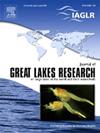在西班牙河,安大略省,加拿大,一个可能的产卵运行cisco Coregonus artedi文件
IF 2.4
3区 环境科学与生态学
Q3 ENVIRONMENTAL SCIENCES
引用次数: 0
摘要
在历史上,劳伦森五大湖的可可碱种类丰富,但由于过度捕捞、栖息地退化以及与入侵物种的相互作用等多种因素,可可碱在19世纪和20世纪有所下降。五大湖渔业管理人员正在努力恢复整个盆地的coregonines。恢复工作的一个重要方面是确定关键栖息地,如产卵栖息地。我们对五大湖coregonine产卵栖息地的范围和多样性的了解是有限的。历史记载表明,一些cisco Coregonus artedi迁移到支流产卵,但当代没有报道。此外,思科表现出相当大的表型变异,不同的“形式”往往占据特定的栖息地或地区。我们为以前没有记载的西斯科在休伦湖北通道的一条支流西班牙河中产卵提供了证据。2022年11月15日至16日,我们在河口上游约52公里处捕获了31条成熟鱼(雄性25条,雌性6条)。鱼龄3 ~ 9岁,体长287 ~ 394毫米。在这31个个体中,27个在形态上与北海峡cisco的亚种C. artedi manitoulinus相似;然而,在休伦湖其他地区捕获的四个人更像思科。这些发现是自19世纪80年代以来cisco在支流产卵的最佳证据,它们对coregonine的保护和恢复工作具有重要意义。正在进行的工作旨在增强我们对这一种群的生态和进化重要性的理解。本文章由计算机程序翻译,如有差异,请以英文原文为准。
Documentation of a probable spawning run of cisco Coregonus artedi in the Spanish River, Ontario, Canada
Coregonines were historically diverse and abundant in the Laurentian Great Lakes but declined throughout the 19th and 20th centuries due to multiple factors, including overfishing, habitat degradation, and interactions with invasive species. Great Lakes fishery managers are now working to restore coregonines across the basin. An important aspect of restoration efforts is the identification of key habitats, such as spawning habitats. Our understanding of the extent and diversity of coregonine spawning habitats in the Great Lakes is limited. Historical accounts suggest some cisco Coregonus artedi migrated to tributaries to spawn, but contemporary runs have not been reported. Moreover, cisco display considerable phenotypic variation, with different “forms” often occupying specific habitats or regions. We provide evidence for a previously undocumented spawning run of cisco in the Spanish River, a tributary to the North Channel of Lake Huron. We captured 31 mature and ripe fish (25 males, 6 females) approximately 52 km upstream of the river mouth on 15–16 November 2022. The fish ranged in age from 3-9 yr and total length from 287-394 mm. Of these 31 individuals, 27 were morphologically similar to C. artedi manitoulinus, a subspecies of cisco found in the North Channel; however, four individuals more closely resembled cisco captured in other areas of Lake Huron. These findings represent the best evidence of tributary spawning by cisco since the 1880s, and they have important implications for coregonine conservation and restoration efforts. Ongoing work aims to augment our understanding of the ecological and evolutionary importance of this population.
求助全文
通过发布文献求助,成功后即可免费获取论文全文。
去求助
来源期刊

Journal of Great Lakes Research
生物-海洋与淡水生物学
CiteScore
5.10
自引率
13.60%
发文量
178
审稿时长
6 months
期刊介绍:
Published six times per year, the Journal of Great Lakes Research is multidisciplinary in its coverage, publishing manuscripts on a wide range of theoretical and applied topics in the natural science fields of biology, chemistry, physics, geology, as well as social sciences of the large lakes of the world and their watersheds. Large lakes generally are considered as those lakes which have a mean surface area of >500 km2 (see Herdendorf, C.E. 1982. Large lakes of the world. J. Great Lakes Res. 8:379-412, for examples), although smaller lakes may be considered, especially if they are very deep. We also welcome contributions on saline lakes and research on estuarine waters where the results have application to large lakes.
 求助内容:
求助内容: 应助结果提醒方式:
应助结果提醒方式:


